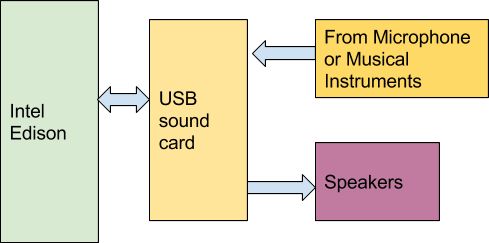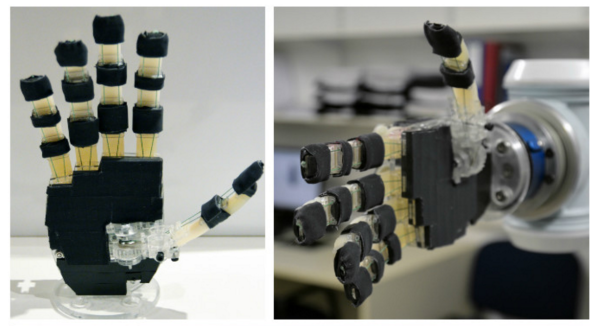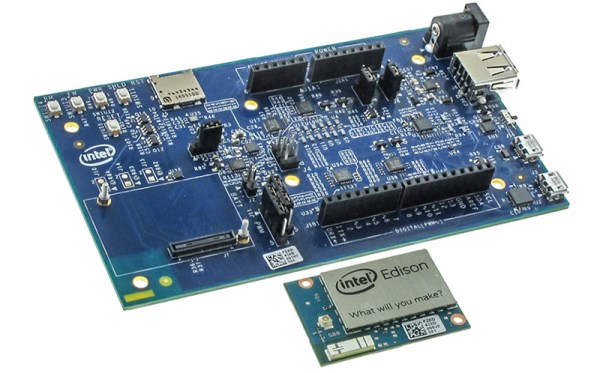Gavin Morris has been working on his awesome sound responsive LED sculptures for a while. Technically the sculpture is an interesting application of WS2812 RGB LEDs, Raspberry Pis and a load of styrofoam cups and flower pots. However the artistic development, and inspiration for this project is equally interesting. Gavin shares his thoughts and a brief technical description of the project below.
Month: December 2015
OpenBionics Fabs Prosthetics As Unique As Those Who Wear Them
Humans may all have the same overall form, but when we need to find a suitable replacement for a missing limb, it’s clear that between the variety of finger-lengths and hand-breadths, a one-size-fits-all prosthetic just wont cut it. OpenBionics puts a spin on today’s approach to prosthetics, putting forth a framework of tools that’s flexible enough to fit the spectrum of hand shapes and enables us to create our own prosthetic at home that can meet the challenge of most everyday tasks.
Minas Liarokapis of the OpenBionics team gave a talk at this year’s Hackaday SuperConference which covered the design considerations and unique features of the project. This incredible work was recognized with 2nd Prize in the 2015 Hackaday Prize. Watch Minas’ talk below, then join us after the break as we cover more details that went into developing this prosthesis.
Continue reading “OpenBionics Fabs Prosthetics As Unique As Those Who Wear Them”
Beyond Control: The Basics Of Control Systems
Control systems are exactly what you think they are: systems designed to control something. Perhaps a better way to put it is systems design control the behavior of something. The term “control systems” does an excellent job of being vague and most of us (originally) don’t think too much about it until its brought to our attention or we crash a robotic armature into itself and investigate how that horrifying event was allowed to happened. Usually during this investigation our internal dialog has a loop running that goes something like: “why the hell will the system allow me to manipulate it in a self-destructive way!?!”
What I found was my own ignorance, I hadn’t implemented a proper control system. One could make a case claiming that I hadn’t taken ANY control system into account whatsoever. I jumped in too deep, too fast (sound familiar?) and paid the price of crashing a rotating arm into another part of the system. Luckily, a friend stepped in and repaired the arm for me and metaphorically pointed to a large neon sign on the wall and said “you can’t ignore this”. He walked over to pull the chain dangling beneath the sign, the high voltage energized the gas in the tubes blinding me with the now unavoidably obvious words: Control Systems.
Continue reading “Beyond Control: The Basics Of Control Systems”
Prototype Sodium Ion Batteries In 18650 Cells
French researchers have announced a prototype of an 18650 sodium-ion battery. If you’ve bought a powerful LED flashlight, a rechargeable battery pack, or a–ahem–stronger than usual LASER pointer, you’ve probably run into 18650 batteries. You often find these inside laptop batteries and –famously– the Tesla electric vehicle runs on a few thousand of these cells. The number might seem like a strange choice, but it maps to the cell size (18 mm in diameter and 65 mm long).
The batteries usually use lithium-ion technology. However, lithium isn’t the only possible choice for rechargeable cells. Lithium has a lot of advantages. It has a high working voltage, and it is lightweight. It does, however, have one major disadvantage: it is a relatively rare element. It is possible to make sodium-ion batteries, although there are some design tradeoffs. But sodium is much more abundant than lithium, which makes up about 0.06% of the Earth’s crust compared to sodium’s 2.6%). Better still, sea water is full of sodium chloride (which we call salt) that you can use to create sodium.
Continue reading “Prototype Sodium Ion Batteries In 18650 Cells”
Hackaday Dictionary: Bluetooth Low Energy
Bluetooth is one of the mainstays of the mobile gadget world, allowing mobile devices to communicate easily over short distances. It’s how your wireless headset talks to your cell phone without the complexity and power requirements of WIFi. In particular, the Bluetooth Low Energy (BLE) component is interesting for those who build portable gadgets, because it requires a very small amount of power. Continue reading “Hackaday Dictionary: Bluetooth Low Energy”
Amazon Dash Button Pwn3d
If you haven’t heard about the Amazon dash button yet we’re glad you quit watching cat videos and have joined us. Just to get you up to speed: the Amazon dash button is a small wireless device that lets your lazy ass order more laundry soap by pushing the “dash button” which should be affixed to something near your washing machine. The pushing of the button will set in motion the gut wrenching process that we used to know as “buying things we ran out of” but thanks to Amazon we can now just cover our entire lives with an assortment of buttons that take zero credentials to physically push. We can’t see that being a problem whatsoever.
Needless to say we as a community set out to find an actual use for these fantastic little devices. [maximus64] has done quite a nice job at enabling this hardware in a most usable way. Most of the hacks we have seen for the dash button remove the physical push button and add a sensor of some kind. Replacing the button with a sensor still uses the WiFi connection to send data from the button to the cloud. Instead of the button ordering more <<product>> from Amazon, a sensor might trigger the dash to increment a counter on your website letting you know that your dog went through the doggy door +1 more times.
[maximus64] has the dash button working in the reverse manner by porting the Broadcom IoT WICED SDK to the button. He is using the dash button as a receiver and when [maximus64] sends the “all good” signal from his laptop to the dash button his garage door opens which you can see in the video after the break. We find this extremely more useful than the dash button’s original intended use. [maximus64] has instructions in the readme.md file of the github repo so that you too can hack your dash button in this way.
Audio Effects On The Intel Edison
With the ability to run a full Linux operating system, the Intel Edison board has more than enough computing power for real-time digital audio processing. [Navin] used the Atom based module to build Effecter: a digital effects processor.
Effecter is written in C, and makes use of two libraries. The MRAA library from Intel provides an API for accessing the I/O ports on the Edison module. PortAudio is the library used for capturing and playing back audio samples.
 To allow for audio input and output, a sound card is needed. A cheap USB sound card takes care of this, since the Edison does not have built-in hardware for audio. The Edison itself is mounted on the Edison Arduino Breakout Board, and combined with a Grove shield from Seeed. Using the Grove system, a button, potentiometer, and LCD were added for control.
To allow for audio input and output, a sound card is needed. A cheap USB sound card takes care of this, since the Edison does not have built-in hardware for audio. The Edison itself is mounted on the Edison Arduino Breakout Board, and combined with a Grove shield from Seeed. Using the Grove system, a button, potentiometer, and LCD were added for control.
The code is available on Github, and is pretty easy to follow. PortAudio calls the audioCallback function in effecter.cc when it needs samples to play. This function takes samples from the input buffer, runs them through an effect’s function, and spits the resulting samples into the output buffer. All of the effect code can be found in the ‘effects’ folder.
You can check out a demo Effecter applying effects to a keyboard after the break. If you want to build your own, an Instructable gives all the steps.

















